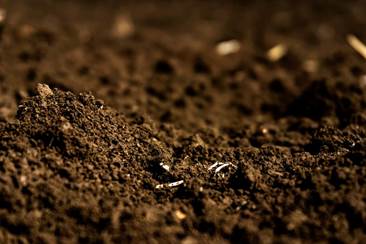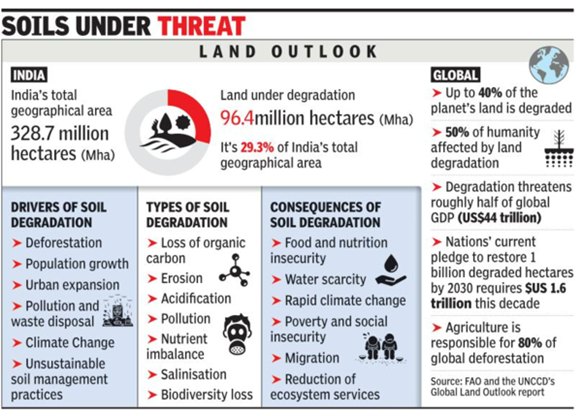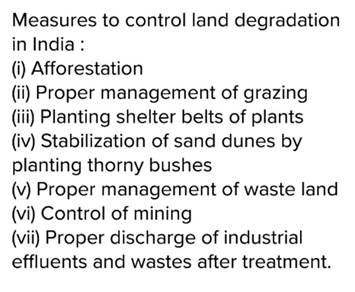Description

Disclaimer: Copyright infringement not intended.
Context
- December 5 is observed as the World Soil Day (WSD), to highlight the value of healthy soil and to promote the sustainable management of soil resources.
Background
- The poor condition of soil leads to degradation, which is a pressing environmental issue all around the world. Soil degradation causes erosion, loss of organic matter and reduces soil fertility.
World Soil Day
- An international day to celebrate soil was recommended by the International Union of Soil Sciences (IUSS) in 2002. Since the first WSD in 2014, the Global Soil Partnership (GSP) people are connecting and working together to preserve soils with each passing year.
- World Soil Day enjoins individuals to consider sustainably managing soil resources. The main goal of the day is to increase public awareness of the significant environmental issues that soil degradation can lead to, such as erosion, the loss of organic matter, and a drop in soil fertility.
- The theme for World Soil Day 2022 is "Soils, where food begins".
What is land degradation/desertification?
- According to the UNCCD, land degradation is the “reduction or loss of biological or economic productivity… resulting from land uses or from a process or combination of processes, including … human activities.”
- Land degradation is driven by both by changes in climate or human activities.
- When land degradation occurs in dryland areas, more specifically arid, semi-arid and dry sub-humid areas, it is referred to as desertification. Around 69 percent of India falls under drylands.
Status of land degradation in India
State of India’s Environment 2022 Report
- The “State of India’s Environment 2022”, a report released by Centre for Science and Environment (CSE) stated that nearly 62% of land in Delhi was under degradation. Almost 30% of India’s geographical area is under degradation.
- Land degradation denoted deterioration or loss of soil productivity for the present and future. In India, agricultural land (46%) and forests (22%) are the two most common kinds of land getting degraded. It affects us all and leads to food insecurity through lower yields and climate change as degraded land releases soil carbon and nitrous oxide into the atmosphere.
- Delhi (25%) is among 14 states that have seen over 10% rise in the share of degraded land between 2003-05 and 2018-19. Among the states that have seen the most degradation, five are in the Northeast. Land in Mizoram (188%), Punjab (80%), Arunachal Pradesh (47%), Assam (46%), Tripura (37%) and Nagaland (29%) degraded the most between 2003-05 and 2018-19. Over 3 million hectares of additional land degraded in India during the same period.
Times of India Report
- Over 29% (96.4 million hectares) of India’s total geographical area (328.7 million hectares) is degraded. If looked at this phenomenon globally, where the land has lost its topsoil that supports life, the extent of degradation in terms of losing soil fertility goes up to 40%, threatening roughly half of the global GDP.
- This has happened due to over-exploitation of land through unsustainable farming practices, mining and deforestation over the centuries. But if the current land degradation trends continue, it would disrupt food supply and lead to rapid biodiversity loss and species extinctions in this century itself. Scientific reports even suggest that the world’s topsoil could become unproductive within 60 years if current rates of loss continue.

Implications
- Land degradation can exacerbate climate change and threaten agricultural productivity, water quality, biodiversity, sustainable development, and the living conditions of humans and wildlife, among other effects.
- Globally, a third of our land is degraded, affecting 3 billion people, and it is expected to worsen with rising demand for food.
Efforts being taken to restore soil
United Nations Convention to Combat Desertification (UNCCD)
- Globally, the countries have, under UNCCD Convention, already decided to restore one billion hectares of degraded land by 2030. India, on its part, has been working to restore 26 million hectares of the country’s degraded land by 2030. It voluntarily pledged to achieve land degradation neutrality (LDN) by 2030.
- The LDN is a stage where the amount and quality of land resources remains stable or increases within specified temporal and spatial scales and ecosystems, factoring in degradation and restoration. Simply put, any country will not have net loss in terms of land degradation if it achieves LDN through restoration efforts.
.jpg)
ZBNF
- Restoring soil fertility by regenerating organic content and microorganism is one of the key components of the whole land restoration exercises. India’s current pitch for fertilizers/pesticides-free ‘zero budget natural farming’ (ZBNF) is also part of this massive exercise.
- The ZBNF guides the farmers towards sustainable farming practices. It helps in not only retaining soil fertility but also ensuring low cost of production (zero cost) and thereby enhancing the farmers income.
National Mission for a Green India (GIM)
- National Mission for a Green India (GIM) is one of the eight Missions under the National Action Plan on Climate Change. It aims at protecting, restoring and enhancing India's forest cover and responding to Climate Change.
Soil Health Card
- The country’s ‘soil health cards’ (SHC) scheme is another attempt which, besides informing farmers of the status of soils, also provides a ground for multiple actions for restoring soil fertility.
Integrated Watershed Management
- Integrated Watershed Management Programme (IWMP) is implemented by Department of Land Resources of Ministry of Rural Development. The main objective of IWMP is to restore ecological balance by harnessing, conserving and developing degraded natural resources such as soil, vegetative cover and water.
National Afforestation Program
- Launched in 2000, the overall objective of the National Afforestation Programme (NAP) scheme is ecological restoration of degraded forests and to develop the forest resources with peoples' participation, with focus on improvement in livelihoods of the forest-fringe communities, especially the poor.
.jpg)

Read: https://www.iasgyan.in/daily-current-affairs/save-soil-movement
https://timesofindia.indiatimes.com/india/over-exploitation-over-centuries-has-degraded-96m-hectares-of-indias-land/articleshow/95988217.cms







.jpg)









